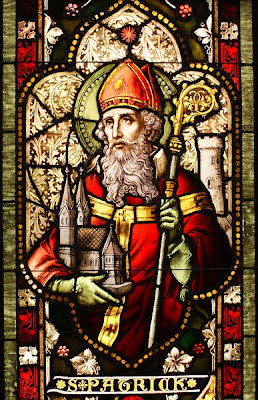Born in Britain to wealthy parents, at (about) 16 years old he was taken prisoner by Irish raiders who were attacking his parents estate, sold into slavery, where he then worked as a shepherd. During his years of slavery, it is believed that he turned to his religion for solace and began to desire to convert the Irish people. He recounts how his faith grew, here are his words recorded in a letter called 'the Confessio':
"But after I reached Hibernia I used to pasture the flock each day and I used to pray many times a day. More and more did the Love of God, and my fear of Him and faith increase, and my spirit was moved so that in a day [I said] from one up to a hundred prayers, and in the night a like number; besides I used to stay out in the forests and on the mountain and I would wake up before daylight to pray in the snow, in icy coldness, in rain, and I used to feel neither ill nor any slothfulness, because, as I now see, the Spirit was burning in me at that time".After 6 years of captivity he recorded a dream in which he believes God's voice told him to leave Ireland.
"And it was there of course that one night in my sleep I heard a voice saying to me: "You do well to fast: soon you will depart for your home country." And again, a very short time later, there was a voice prophesying: "Behold, your ship is ready." And it was not close by, but, as it happened, two hundred miles away, where I had never been nor knew any person. And shortly thereafter I turned about and fled from the man with whom I had been for six years, and I came, by the power of God who directed my route to advantage (and I was afraid of nothing), until I reached that ship."
After he walked 200 miles to the Irish coast to reach that ship, he records this reaction from those on the ship:
"And on the same day that I arrived, the ship was setting out from the place, and I said that I had not the wherewithal to sail with them; and the steersman was displeased and replied in anger, sharply: "By no means attempt to go with us." Hearing this I left them to go to the hut where I was staying, and on the way I began to pray, and before the prayer was finished I heard one of them shouting loudly after me: "Come quickly because the men are calling you." And immediately I went back to them and they started to say to me: "Come, because we are admitting you out of good faith; make friendship with us in any way you wish."Once again in Britain he records he had another dream of an angel telling him to return to Ireland as a missionary:
"I saw a man coming, as it were from Ireland. His name was Victoricus, and he carried many letters, and he gave me one of them. I read the heading: "The Voice of the Irish". As I began the letter, I imagined in that moment that I heard the voice of those very people who were near the wood of Foclut, which is beside the western sea—and they cried out, as with one voice: "We appeal to you, holy servant boy, to come and walk among us.He studied for 15years to became a priest and then as a priest was sent to Ireland again with the direction to minister to Christians who already lived in Ireland and to convert the Irish to Christianity. Much of Ireland at that time practiced a nature based religion. St. Patrick used many symbols and traditions from that religion to teach about Christianity, such as superimposing the sun on a cross (which is now the Celtic cross), building bonfires as they honored their gods with fire, and it is believed that he may have used a three leafed clover to teach about the Trinity. He started over 300 churches in Ireland and by the 7th century had become the patron saint of Ireland. March 17, the day we celebrate St. Patrick's Day is believed to have been his death date in 460 AD. The St. Patrick's Day tradition was originally brought to America and made popular by Irish immigrants. And today in Ireland is a day to remember St. Patrick and celebrate the Irish culture.
More info: You can read a translated version St. Patrick's letter 'the confessio' here:"Confessio of Saint Patrick" it is a powerful read and not for the faint of heart! See a prayer that is was thought to have been written by him here: St Patrick's Breast-Plate. And you can see my post about the St. Patrick's Bell here: The Shrine of St. Patrick.
Sources: Wikipedia (where credible sources listed), history.com, St. Patrick's quotes came from the translated version of the Confessio listed above.
Photo credit: NeitherFanboy's photo stream on flicker listed under the 2.0/generic license


















